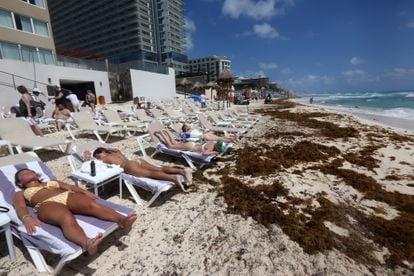An immense brown tide of algae has begun to reach the shores of the Mexican Caribbean.
Since 2011, sargassum has become the unwelcome guest on Mexican beaches, mainly in the state of Quintana Roo, one of Mexico's tourist gems.
In the last week alone, the arrival of more than 23,000 tons of the organism has been registered and the authorities foresee a massive arrival this season and with it the urgent need to clean the area to prevent its decomposition from causing more damage to the environment.
Hundreds of kilometers away, some offshore platforms installed in the Gulf of Mexico may provide a solution against this organic invasion that seems to win the battle year after year for tourists and tour operators.
The researcher Juan Carlos Herguera García, from the Ensenada Center for Scientific Research and Higher Education (Cicese) is one of the more than 300 experts that make up the network of the Gulf of Mexico Research Consortium (CIGoM), founded in 2015 on behalf of Pemex, to develop observations and learn about possible scenarios in the event of an oil spill in the Gulf of Mexico.
The expert explains that derived from oceanographic observation they have managed to develop a vast knowledge that could be applied to other phenomena, for example, in hurricanes or with sargassum.
“We want to have some tools to be able to anticipate sargassum arrivals with a week, or a few days,
A few days before the holiday period begins for Easter, the authorities of the State of Quintana have warned that the arrival of sargassum has been "excessive" and they locate that in at least 33 beaches they detect the presence of algae to some degree and particularly high. particularly at two points: from Xcalak to the outskirts of Cancún and to the east and south of the island of Cozumel.
Faced with this scenario, Dr. Julio Sheinbaum, from Physical Oceanography at Cicese —and also a member of CIGoM— specifies that sargassum is transported by ocean currents, waves and wind, so a likely explanation for the massive volume of sargassum this year could be derived from the greater intensity of winds compared to the previous year.
“In March 2022, westerly winds were stronger than in March 2021. Differences in zonal wind intensity and currents between 2022 and 2021 suggest a plausible explanation, but not definitive proof, of the current distribution of sargassum. ", mentions.
Tourists sunbathe surrounded by sargassum in Playa Coral, Cancun, this Tuesday. Alonso Cupul (EFE)
The giant brown tide of foul-smelling sargassum that clashes with tourists' photographs is a real and latent concern for Mexican researchers thousands of meters deep.
“The greatest threat is the real possibility that the reef system of the entire region will not withstand the massive influx of nutrients resulting from the decomposition of sargassum and that the lack of light and the presence of sulfur compounds, among others, will lead to a eutrophication of the system leads to the massive death of corals,” says Sheinbaum.
The Cicese researchers' proposal is that the observation network used to study the depths of the Gulf of Mexico now be used to monitor sargassum in the Mexican Caribbean.
“In these seas we have observation windows to be able to understand its dynamics, because sargassum does not move like a hydrocarbon slick, now we are talking about a living organism, sargassum is an algae and has its own dynamics and that is why we have not yet we understand very well what favors it, what forces it to continue growing or what makes it disappear”, asserts Helguera García.
The researcher anticipates that they are currently in talks with the National Council for Science and Technology (Conacyt) about the project.
The investment to develop oceanographic observation for the degradation of hydrocarbons in the Gulf of Mexico involved some 1,600 million pesos.
Herguera García calculates that in order to place this same information infrastructure in the Mexican Caribbean for sargassum, 10 to 20 million pesos will be required, while the proposal for an anticipation plan will imply a budget of up to 50% more, that is, in a range of 15 to 30 million pesos.
The specialist concludes that the sargassum problem is an international phenomenon that requires the will not only of Mexico, but also the effort and political will of the Caribbean countries to find a coordinated and joint solution.
"We want to start conversations with different government agencies and private industry, which have information needs about the ocean and its behavior with a vision of the future," he settles.
subscribe here
to the
newsletter
of EL PAÍS México and receive all the informative keys of the current affairs of this country

